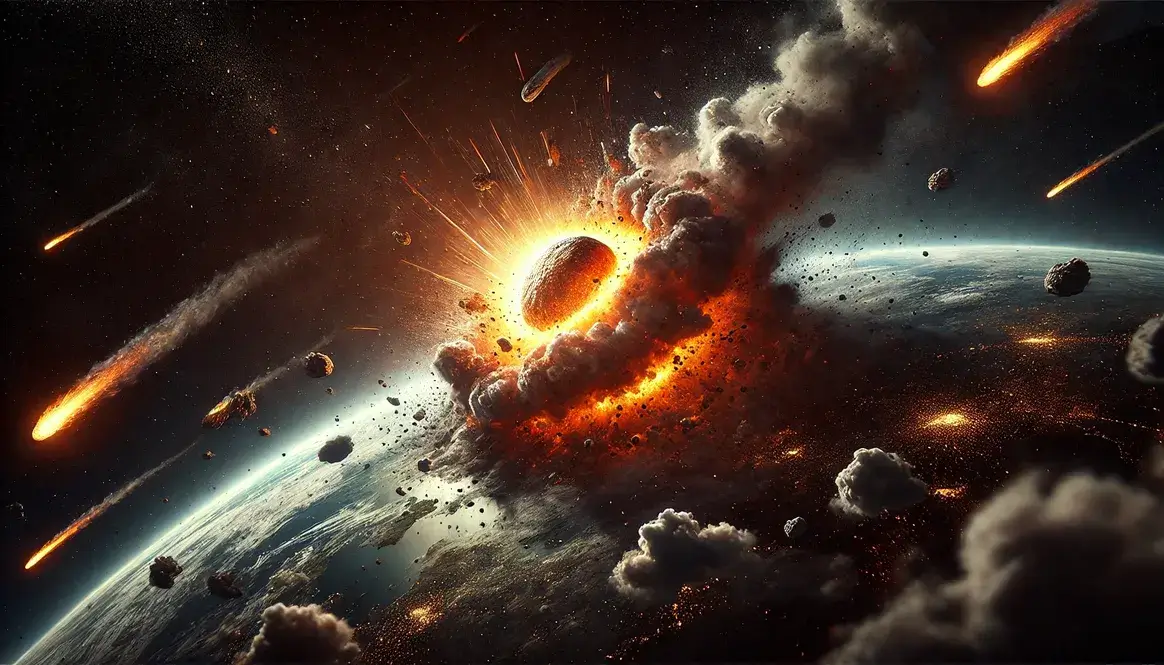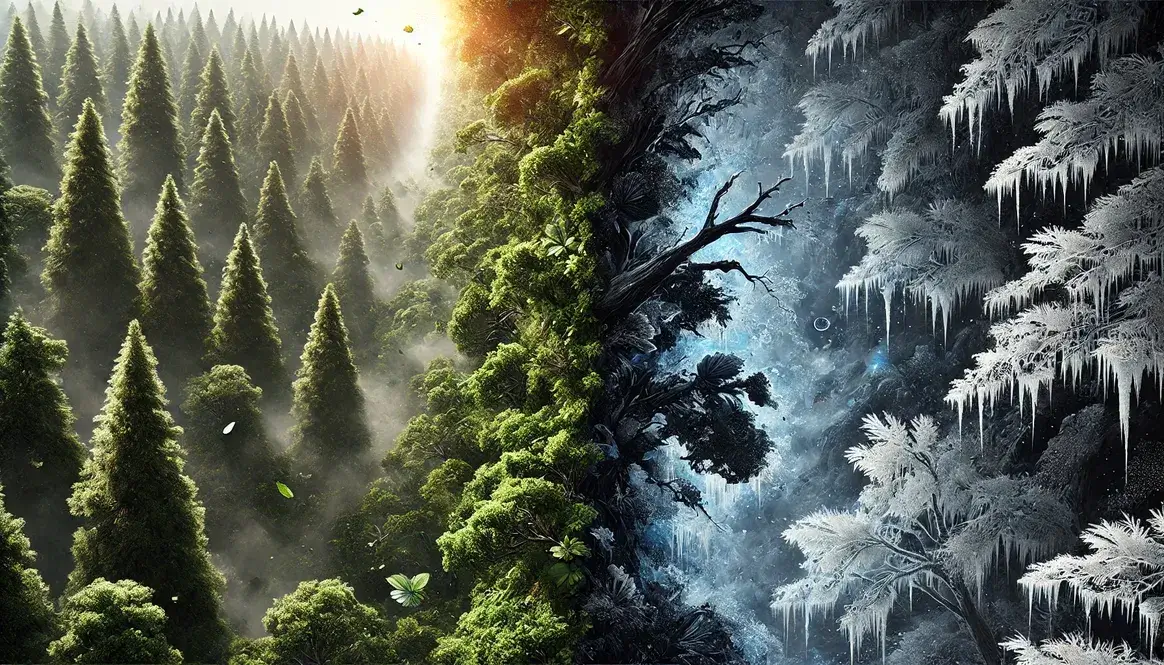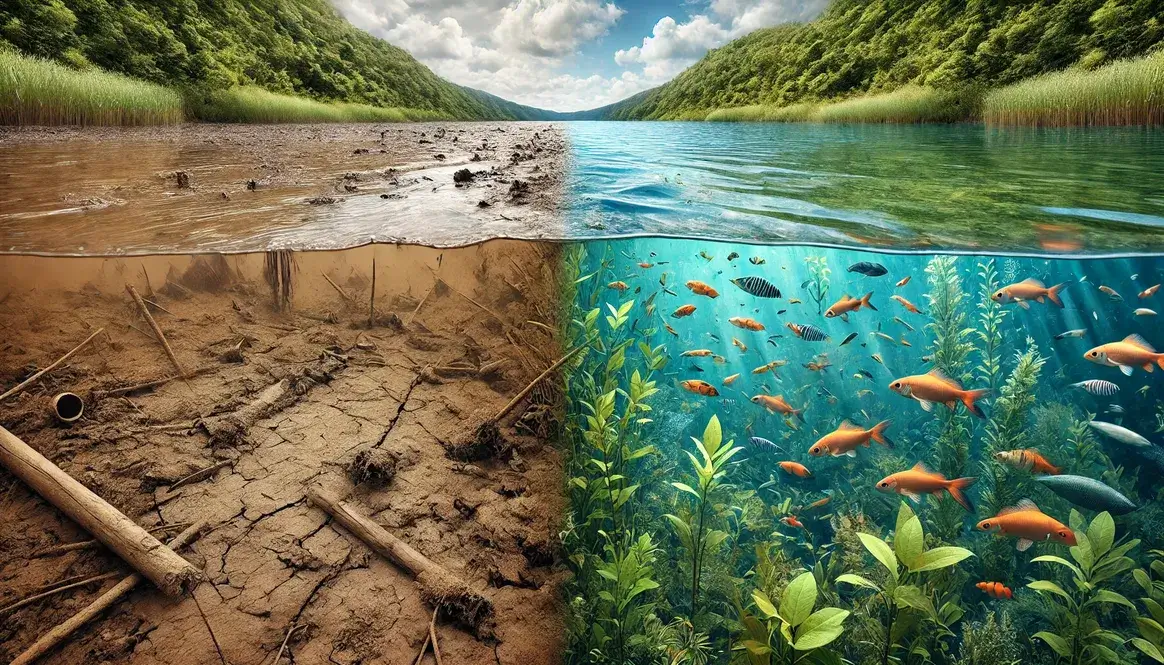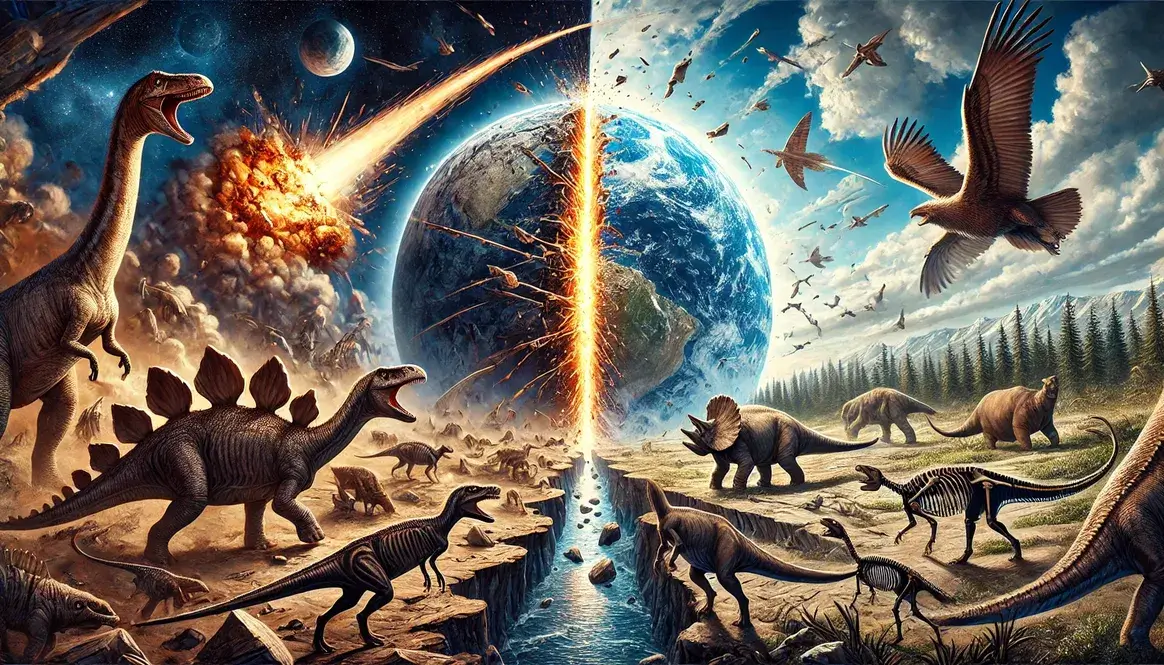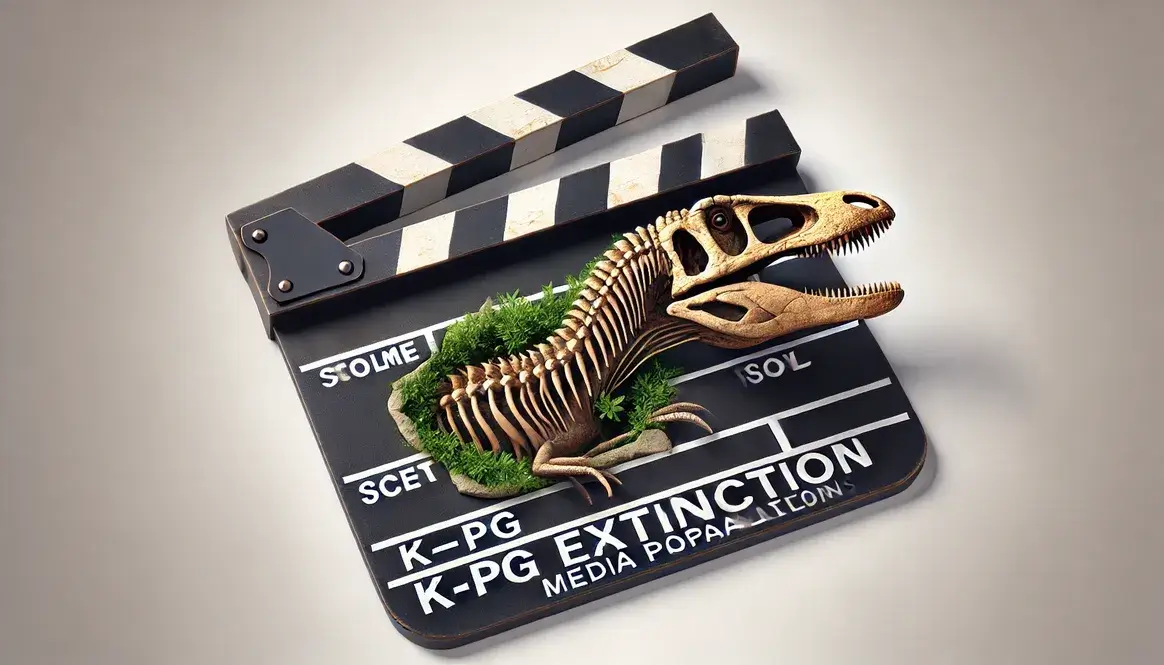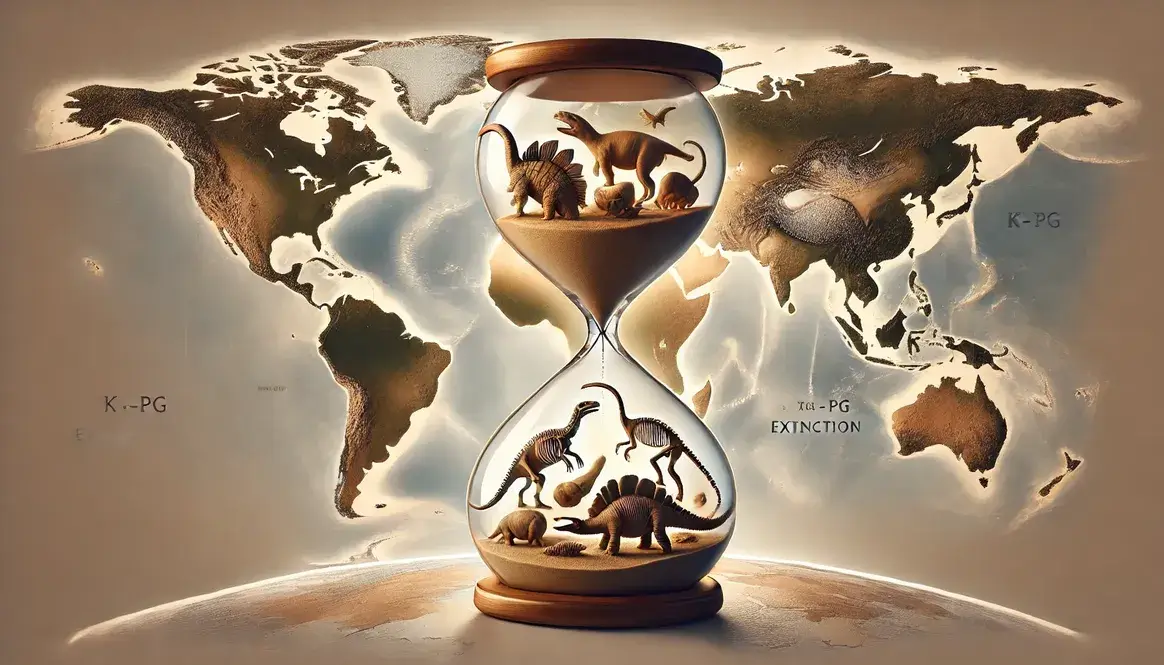The End of the Dinosaur Era
Imagine a world where giant reptiles roamed the earth, soaring through the skies, and swimming in vast oceans. This was the reality of our planet for over 160 million years. But then, in what seems like the blink of an eye in geological time, it all changed. This monumental shift in Earth’s history is known as the Cretaceous-Paleogene extinction event, or K-Pg for short.
The K-Pg extinction event marks one of the most significant turning points in our planet’s 4.5-billion-year history. It’s the moment when the age of dinosaurs came to an abrupt end, paving the way for the rise of mammals and eventually, us humans. This event reshaped life on Earth in ways we’re still uncovering today, making it a crucial chapter in the story of our planet.
Cretaceous-Paleogene Extinction Event explained
The Cretaceous-Paleogene Extinction Event explained is a tale of global catastrophe. It refers to a mass extinction that occurred approximately 66 million years ago, marking the end of the Cretaceous period and the beginning of the Paleogene period.
But what exactly is a mass extinction? It’s a period when an unusually high number of plant and animal species die out in a relatively short time. In the case of the K-Pg event, this “short time” was geologically speaking, very brief indeed.
The scale of this extinction was enormous. Scientists estimate that about 75% of plant and animal species on Earth vanished during this event. This includes all non-avian dinosaurs, many marine reptiles, flying reptiles, and countless plant species.
To put this into perspective, let’s look at the numbers:
| Category | Percentage Extinct |
|---|---|
| Land Vertebrates | ~75% |
| Marine Species | ~75% |
| Plant Species | ~60% |
| Insect Species | ~40% |
These figures show the widespread impact of the event across different ecosystems. The K-Pg extinction wasn’t just about the dinosaurs; it was a global reset button for life on Earth.
The suddenness and severity of this extinction make it stand out in Earth’s history. While our planet has experienced several mass extinctions, the K-Pg event is particularly notable for its rapid onset and far-reaching consequences. It’s a stark reminder of how quickly life on Earth can change, and how resilient it can be in the face of catastrophe.
In the following sections, we’ll explore the world before this cataclysmic event, what caused it, and how life on Earth recovered in its aftermath. This journey through time will help us understand not just our planet’s past, but also gain insights into its present and future.
The Cretaceous World Before the Extinction
Before the Cretaceous-Paleogene extinction event, Earth was a very different place. The late Cretaceous period, spanning from about 100 to 66 million years ago, was a time of incredible biodiversity and unique environmental conditions.
A World Dominated by Dinosaurs
Dinosaurs ruled the land during this period, having evolved into a wide variety of forms. From the towering long-necked sauropods to the fearsome predatory theropods, these creatures had adapted to fill nearly every ecological niche on land.
But dinosaurs weren’t the only impressive animals around:
- In the skies: Pterosaurs soared overhead, some with wingspans as wide as small airplanes.
- In the seas: Marine reptiles like mosasaurs and plesiosaurs dominated the oceans.
- On land: Early mammals scurried about, mostly small and nocturnal, living in the shadow of the dinosaurs.
Lush and Varied Ecosystems
The Cretaceous world was lush and green, with forests covering much of the land. These weren’t the forests we know today, though. Flowering plants had just begun to diversify, competing with the older cycads, conifers, and ferns.
Imagine walking through a Cretaceous forest. You’d see towering conifers and tree ferns, with early flowering plants beginning to appear in clearings and along forest edges. The air would be filled with unfamiliar scents and the buzz of ancient insects.
A Warm and Stable Climate
The climate during the late Cretaceous was generally warmer than today, with no polar ice caps. This led to higher sea levels, creating shallow seas that covered much of what is now dry land.
Here’s a quick comparison of Cretaceous and modern climate conditions:
| Aspect | Late Cretaceous | Modern Era |
|---|---|---|
| Average Global Temperature | 18-20°C (64-68°F) | 15°C (59°F) |
| Polar Ice Caps | Absent | Present |
| Sea Level | Up to 200m higher | Current level |
| CO2 Levels | 4-5 times higher | Current level |
This warm, stable climate allowed life to flourish in areas that are now much cooler. Dinosaurs in polar regions adapted to seasonal changes in daylight rather than extreme cold.
The Cretaceous world was a paradise for many species, having had millions of years to adapt and evolve in these conditions. But this long period of relative stability was about to come to a dramatic end. The stage was set for one of the most significant events in Earth’s history, an event that would reshape life on our planet forever.
The Impact: A Cosmic Collision
The Cretaceous period ended with a bang—literally. The culprit? A massive space rock on a collision course with Earth.
The Chicxulub Impactor
In the 1980s, scientists made a groundbreaking discovery. They found evidence of an enormous impact crater buried beneath the Yucatán Peninsula in Mexico. This crater, named Chicxulub after a nearby town, was the smoking gun that helped explain the K-Pg extinction event.
The Chicxulub impactor was no ordinary space rock. Here’s what we know about it:
- Size: Estimated to be about 10-15 kilometers (6-9 miles) wide
- Composition: Likely an asteroid, though some scientists argue it could have been a comet
- Speed: It struck Earth at an estimated speed of 20 kilometers per second
To put this in perspective, imagine an object about the size of Mount Everest slamming into Earth at 60 times the speed of sound. The energy released by this impact was equivalent to billions of atomic bombs detonating at once.
The discovery of the Chicxulub crater was a game-changer in our understanding of the K-Pg extinction. It provided strong evidence for the impact theory, which had been proposed years earlier based on the presence of unusual levels of iridium (an element rare on Earth but common in asteroids) in K-Pg boundary clay layers worldwide.
Immediate Effects of the Impact
The moment the Chicxulub impactor struck Earth, it set off a chain of catastrophic events that would reshape our planet.
- Global Wildfires
The impact generated an immense amount of heat, igniting wildfires that spread across the globe. These weren’t just ordinary forest fires—they were infernos that raged across continents. The smoke and soot from these fires would have further darkened the skies, adding to the cooling effect of the impact.
- Tsunamis and Earthquakes
When the impactor hit, it created massive tsunamis that swept across the oceans. These giant waves, possibly hundreds of meters high, would have devastated coastal areas worldwide. The impact also triggered earthquakes far more powerful than anything we experience today.
- Dust and Aerosols in the Atmosphere
Perhaps the most significant long-term effect came from what was thrown into the air. The impact vaporized rock, sending a plume of superheated material into the atmosphere. As this material cooled, it formed tiny particles that spread around the globe.
This global dust cloud had severe consequences:
| Effect | Duration | Impact |
|---|---|---|
| Blocked Sunlight | Months to Years | Global cooling, plant die-off |
| Acid Rain | Months | Ocean acidification, soil changes |
| Ozone Depletion | Years | Increased UV radiation reaching Earth’s surface |
The dust and aerosols created what scientists call an impact winter, a period of prolonged global cooling. This dramatic climate shift would have profound effects on life around the world, setting the stage for one of the greatest mass extinctions in Earth’s history.
In the blink of a geological eye, the world of the dinosaurs was turned upside down. But the story doesn’t end here. The aftermath of this cosmic collision would reshape life on Earth in ways that are still influencing our world today.
The Aftermath: Earth in Crisis
In the wake of the Chicxulub impact, Earth entered a period of profound crisis. The immediate effects of the collision set off a cascade of environmental changes that would test the limits of life’s resilience.
Short-term Consequences
Global Cooling (Impact Winter)
The dust and aerosols thrown into the atmosphere by the impact had a dramatic cooling effect on the planet. This phenomenon, known as an impact winter, plunged Earth into a deep freeze.
- Temperature Drop: Global temperatures may have fallen by as much as 10°C (18°F) within days.
- Duration: The most severe cooling likely lasted for months to years.
- Effect on Life: This sudden cold snap was particularly challenging for cold-blooded animals like dinosaurs, which relied on external heat to regulate their body temperature.
The impact winter effects were not uniform across the planet. Regions closer to the poles likely experienced more severe cooling, while equatorial areas may have been somewhat buffered from the worst effects.
Darkness and Photosynthesis Shutdown
Imagine a world plunged into darkness. The dust and soot in the atmosphere blocked out the sun, creating what scientists call a “photosynthesis shutdown.”
This darkness had far-reaching consequences:
- Plant Die-off: Without sunlight, plants couldn’t photosynthesize. Many species, especially those adapted to the warm, sunny Cretaceous climate, would have died within weeks.
- Food Web Collapse: As plants died, herbivores lost their food source. This, in turn, affected carnivores up the food chain.
- Ocean Productivity Crash: Phytoplankton, the base of many marine food webs, also rely on photosynthesis. Their decline would have had ripple effects throughout ocean ecosystems.
The darkness after the impact may have lasted for months, long enough to cause widespread extinction in both terrestrial and marine ecosystems.
Acid Rain and Ocean Acidification
As if darkness and cold weren’t enough, the impact also triggered chemical changes in the atmosphere and oceans.
The collision vaporized sulfur-rich rocks, releasing sulfur dioxide into the atmosphere. When this combined with water vapor, it formed sulfuric acid, leading to acid rain. This acid rain had severe effects on both land and sea:
| Environment | Effects of Acid Rain |
|---|---|
| Terrestrial | Soil acidification, plant stress, freshwater acidification |
| Marine | Ocean acidification, disruption of marine food webs |
Ocean acidification was particularly devastating. Many marine organisms, especially those with calcium carbonate shells or skeletons, struggled to survive in the more acidic water. This included many species of plankton, corals, and mollusks.
The combination of these short-term consequences created a perfect storm for mass extinction. The rapid changes overwhelmed the ability of many species to adapt, leading to a dramatic reshaping of life on Earth.
As we’ll see in the next section, while these short-term effects were severe, they set in motion longer-term changes that would continue to influence Earth’s climate and ecosystems for thousands of years to come.
Long-term Environmental Changes
While the immediate aftermath of the Chicxulub impact was catastrophic, the long-term environmental changes that followed were equally transformative. These changes played a crucial role in shaping the post-extinction world and influenced the course of evolution for millions of years to come.
Climate Fluctuations
The impact winter eventually gave way to a period of climate instability. As the dust settled and greenhouse gases accumulated in the atmosphere, Earth experienced significant temperature swings.
- Initial cooling phase: Lasted several years to decades
- Subsequent warming period: Potentially lasted thousands of years
- Return to equilibrium: Took tens of thousands of years
These climate fluctuations created a challenging environment for surviving species. Organisms that could adapt to rapidly changing conditions had an evolutionary advantage. This period of instability may have contributed to the rapid evolution of mammals in the early Paleogene period.
Changes in Atmospheric Composition
The Chicxulub impact left a lasting mark on Earth’s atmosphere. The collision released enormous amounts of carbon dioxide from vaporized rocks and widespread fires. This, combined with other factors, led to significant changes in atmospheric composition:
- Increased CO2 levels: Contributing to long-term warming
- Reduced oxygen content: Potentially challenging for some organisms
- Altered nitrogen cycle: Impacting plant growth and ecosystem recovery
These atmospheric changes had far-reaching effects on global climate and ecosystems. For instance, the increased CO2 levels likely contributed to a period of global warming following the initial impact winter. This warming may have lasted for thousands of years, further stressing ecosystems already reeling from the initial catastrophe.
Altered Ocean Currents and Chemistry
The oceans, covering most of Earth’s surface, underwent profound changes in the wake of the K-Pg extinction event. These changes affected both the physical circulation of the oceans and their chemical composition.
Ocean currents, which play a crucial role in distributing heat and nutrients around the planet, were disrupted. The reasons for this disruption were complex:
- Changes in global temperature gradients
- Altered wind patterns due to atmospheric changes
- Potential shifts in ocean basin geometry due to tectonic movements
The K-Pg extinction ocean effects were not limited to physical changes. The chemistry of the oceans was also significantly altered:
| Chemical Change | Cause | Effect |
|---|---|---|
| Acidification | CO2 absorption, acid rain | Challenging for shell-forming organisms |
| Nutrient cycling disruption | Collapse of marine food webs | Slow recovery of ocean productivity |
| Oxygen depletion in some areas | Reduced circulation, decomposition of organic matter | Creation of “dead zones” |
These changes in ocean chemistry and circulation patterns had long-lasting effects on marine ecosystems. They influenced the types of organisms that thrived in the post-extinction oceans and shaped the evolution of marine life for millions of years.
The long-term environmental changes following the K-Pg extinction event created a world very different from the one that existed before. This new environment presented both challenges and opportunities for surviving species, setting the stage for the rise of new dominant life forms in the age of mammals.
Extinction Patterns: Who Survived and Who Perished
The Cretaceous-Paleogene extinction event was not an equal-opportunity destroyer. Some groups of organisms were hit harder than others, while a few managed to weather the storm. Let’s explore the fate of some major groups during this tumultuous time.
Major Groups Affected
Non-avian Dinosaurs
The most famous victims of the K-Pg extinction were undoubtedly the non-avian dinosaurs. These magnificent creatures, which had dominated terrestrial ecosystems for over 160 million years, met their end in a geological instant.
- Theropods: From the mighty T. rex to the swift Velociraptor, theropod extinction patterns show a complete wipeout of non-avian species.
- Sauropods: The long-necked giants couldn’t survive the global catastrophe.
- Ornithischians: Herbivores like Triceratops and Ankylosaurus also perished.
Why were dinosaurs so vulnerable? Several factors likely contributed:
- Large body sizes requiring substantial food intake
- Potentially slower reproduction rates compared to smaller animals
- Inability to shelter from extreme environmental conditions
It’s important to note that not all dinosaurs went extinct. The ancestors of modern birds, which were small, feathered theropod dinosaurs, managed to survive and eventually thrive in the post-extinction world.
Marine Reptiles
The oceans of the Cretaceous period were home to a diverse array of large marine reptiles. These formidable predators, which had ruled the seas for millions of years, were another casualty of the K-Pg extinction.
The major groups affected included:
- Mosasaurs: These powerful, serpentine swimmers disappeared completely.
- Plesiosaurs: Both long-necked and short-necked varieties went extinct.
- Ichthyosaurs: While many ichthyosaur lineages had already declined before the K-Pg event, the last remaining species vanished at this time.
The extinction of these marine reptiles left ecological niches that would eventually be filled by mammals like whales and dolphins. The K-Pg extinction ocean effects were profound, reshaping marine ecosystems for millions of years to come.
Flying Reptiles
The skies of the Mesozoic era were dominated by pterosaurs, a diverse group of flying reptiles. These incredible creatures, with wingspans ranging from the size of a sparrow to that of a small airplane, were also victims of the K-Pg extinction.
Pterosaurs had been in decline for some time before the extinction event, but the Chicxulub impact delivered the final blow. All pterosaur lineages, from the small, insect-eating anurognathids to the massive azhdarchids, disappeared from the fossil record at the K-Pg boundary.
The extinction of pterosaurs left the skies open for the radiation of birds, which had already begun to diversify in the late Cretaceous. This transition marked a significant shift in the nature of flying vertebrates on our planet.
In the next section, we’ll explore the organisms that managed to survive this cataclysmic event, and how they went on to shape the post-extinction world.
Survivors
While the K-Pg extinction event was devastating for many species, some groups managed to survive and even thrive in its aftermath. These survivors became the ancestors of many of the species we see today, shaping the modern world in profound ways.
Certain mammals, birds, and reptiles
Among the survivors, three groups stand out: mammals, birds, and certain reptiles. Each of these groups had unique characteristics that helped them weather the extinction event.
- Mammals: Small, nocturnal mammals were among the lucky survivors. Their ability to burrow, hibernate, and eat a varied diet likely contributed to their survival. These early mammals laid the foundation for the incredible diversity we see today, from tiny shrews to massive whales.
- Birds: As mentioned earlier, birds are actually living dinosaurs. The survival of bird ancestors through the K-Pg extinction is a fascinating story of evolutionary success. Their small size, ability to fly, and diverse diets may have been key to their survival.
- Reptiles: While many reptile groups were hit hard by the extinction, some managed to pull through. Crocodilians, for example, survived and continue to thrive today. Their semi-aquatic lifestyle and ability to go long periods without food may have helped them survive the initial crisis.
Here’s a quick look at some of the surviving groups:
| Group | Examples of Survivors | Possible Survival Advantages |
|---|---|---|
| Mammals | Ancestral placentals and marsupials | Small size, burrowing ability, varied diet |
| Birds | Ancestral neornithines (modern birds) | Flight, small size, varied diet |
| Reptiles | Crocodilians, turtles, lizards, snakes | Aquatic or burrowing lifestyles, cold-blooded metabolism |
Survival strategies and adaptations
The survivors of the K-Pg extinction didn’t make it through by chance alone. They possessed certain traits and behaviors that gave them an edge in the post-impact world.
Size mattered: Smaller animals had several advantages during this crisis:
- Required less food to survive
- Could hide more easily from predators
- Able to shelter in burrows or crevices from extreme temperatures
Dietary flexibility was crucial. Animals that could eat a variety of foods were more likely to find sustenance in the drastically altered ecosystems. For instance, early mammals were often omnivorous, able to eat seeds, insects, and small vertebrates.
Metabolic adaptations played a role too. Cold-blooded animals like crocodiles and turtles could survive long periods without food, an invaluable trait when ecosystems collapsed.
Some animals also had behavioral adaptations that proved beneficial:
- Burrowing: Allowed animals to escape extreme temperatures and find food underground
- Hibernation or torpor: Enabled survival through periods of food scarcity
- Migration: Birds could potentially fly to less affected areas
It’s important to note that survival wasn’t just about making it through the immediate aftermath of the impact. The animals that survived K-Pg extinction also had to be able to thrive in the changed world that followed. This ability to adapt to new conditions set the stage for the rapid evolution and diversification that occurred in the early Paleogene period.
The survival of these groups through the K-Pg extinction event had profound implications for the future of life on Earth. In the next section, we’ll explore how these survivors went on to shape the post-extinction world, leading to the diverse ecosystems we see today.
Alternative Theories: Beyond the Impact
While the Chicxulub impact theory is widely accepted as the primary cause of the K-Pg extinction, scientists continue to explore other factors that may have contributed to this global catastrophe. Let’s delve into some alternative theories that offer a more complex picture of the extinction event.
Deccan Traps Volcanism
One of the most significant alternative theories focuses on the role of massive volcanic eruptions in India, known as the Deccan Traps. These eruptions were not your average volcanic activity – they were on a scale that’s hard to comprehend.
Extent and duration of volcanic activity
The Deccan Traps represent one of the largest volcanic events in Earth’s history. Here’s what we know about their scale:
- Area covered: Approximately 500,000 square kilometers (193,000 square miles)
- Volume of lava: Estimated at 1.3 million cubic kilometers (312,000 cubic miles)
- Duration: Eruptions lasted for about 800,000 years, spanning the K-Pg boundary
To put this in perspective, imagine an area larger than California covered in lava over a kilometer deep. The Deccan Traps volcanism was truly a geological wonder.
Potential effects on global climate
The Deccan Traps eruptions would have had significant impacts on global climate:
- Greenhouse gas emissions: Released vast amounts of CO2, potentially leading to global warming
- Sulfur dioxide release: Could have caused short-term cooling and acid rain
- Particulate matter: May have blocked sunlight, leading to global cooling
Some scientists argue that these long-term volcanic effects could have stressed global ecosystems, making them more vulnerable to the sudden impact of the Chicxulub asteroid.
Multiple Causes Hypothesis
In recent years, many scientists have begun to favor a “multiple causes” hypothesis for the K-Pg extinction. This theory suggests that a combination of factors, rather than a single event, led to the mass extinction.
Combination of impact and volcanism
The multiple causes hypothesis proposes that the Chicxulub impact and the Deccan Traps volcanism worked together to create a “one-two punch” that devastated global ecosystems. Here’s how this might have played out:
- Deccan Traps eruptions stress global ecosystems over hundreds of thousands of years
- Chicxulub impact delivers a sudden, catastrophic blow
- Combined effects overwhelm the ability of many species to adapt and survive
This theory helps explain some puzzling aspects of the fossil record, such as evidence of gradual declines in some species before the sudden extinction event.
Other potential contributing factors
Beyond the impact and volcanism, scientists have identified other factors that may have contributed to the K-Pg extinction:
- Sea level changes: Fluctuations in sea level during the late Cretaceous could have stressed coastal ecosystems
- Climate change: Evidence suggests the Earth was cooling slightly in the late Cretaceous, potentially making some species more vulnerable
- Ecological interactions: Changes in one group of organisms (like marine reptiles) could have had cascading effects through ecosystems
| Factor | Timescale | Potential Impact |
|---|---|---|
| Deccan Traps | Hundreds of thousands of years | Gradual ecosystem stress |
| Sea level changes | Millions of years | Habitat loss for coastal species |
| Climate cooling | Millions of years | Stress on temperature-sensitive species |
| Chicxulub impact | Instantaneous | Sudden, catastrophic changes |
The K-Pg extinction research continues to evolve as new evidence comes to light. While the Chicxulub impact remains the leading candidate for the primary cause of the extinction, it’s becoming increasingly clear that the full story is more complex.
By considering multiple factors, scientists are painting a more nuanced picture of this pivotal moment in Earth’s history. This approach not only helps us understand the past but also provides valuable insights into how multiple stressors can interact to affect global ecosystems today.
Recovery and the Dawn of a New Era
After the devastation of the K-Pg extinction event, life on Earth entered a period of recovery and renewal. This era of rebirth would shape the world as we know it today, setting the stage for the rise of new dominant species and ecosystems.
Timescale of ecosystem recovery
The recovery of Earth’s ecosystems after the K-Pg extinction was a gradual process that unfolded over millions of years. Different environments recovered at different rates:
- Oceans: Marine ecosystems began to show signs of recovery within a few thousand years, with new species filling niches left vacant by extinct groups.
- Land: Terrestrial ecosystems took longer to bounce back, with full recovery taking up to several million years.
- Plant life: The recovery of plant communities was crucial for the rebound of animal life. Evidence suggests that ferns were among the first plants to recolonize many areas, followed by a gradual return of more complex plant species.
The K-Pg extinction land changes were profound, and it took time for new stable ecosystems to establish themselves. Scientists have identified several phases in the recovery process:
- Survival phase: Immediately after the extinction, only the hardiest species survived.
- Recovery phase: Gradually, surviving species began to diversify and fill empty niches.
- Expansion phase: New groups began to evolve and spread, leading to the establishment of new ecosystem structures.
Diversification of surviving groups
The aftermath of the K-Pg extinction presented a world of opportunity for the surviving species. With many ecological niches left vacant, evolution kicked into high gear.
Some notable examples of post-extinction diversification include:
- Plants: Flowering plants (angiosperms) underwent rapid diversification, eventually coming to dominate many terrestrial ecosystems.
- Insects: Many insect groups expanded and evolved alongside flowering plants, leading to new pollination relationships.
- Fish: Teleost fish, which had been present but not dominant in the Cretaceous, underwent a spectacular radiation in the early Paleogene.
This period of rapid evolution and diversification is sometimes referred to as an “evolutionary explosion.” It demonstrates the resilience of life and its ability to adapt to new conditions.
The rise of mammals and modern birds
Perhaps the most significant change in the post-K-Pg world was the rise of mammals and modern birds to ecological dominance. These groups, which had lived in the shadow of the dinosaurs for millions of years, now had the opportunity to evolve into a wide variety of new forms.
Mammals: The evolution of mammal groups after the K-Pg extinction is a remarkable story of adaptation and diversification. Within a few million years, mammals had evolved to fill many of the niches previously occupied by dinosaurs:
- Large herbivores (like early ancestors of elephants and horses)
- Predators (early carnivores that would eventually give rise to cats, dogs, and bears)
- Flying mammals (bats evolved within 10 million years of the extinction)
- Aquatic mammals (early whales returned to the sea about 55 million years ago)
Birds: Modern birds, the surviving lineage of theropod dinosaurs, also underwent a spectacular radiation:
- Diversified into many new species and body forms
- Evolved specialized beaks for different diets
- Developed a wide range of flight styles and non-flight adaptations
By about 30 million years after the K-Pg extinction, the world had taken on a more familiar appearance, with mammals and birds filling many of the roles previously held by non-avian dinosaurs and other extinct groups.
This new era, shaped by the survivors of the K-Pg extinction, set the stage for the eventual evolution of humans. In this way, the catastrophic event that ended the age of dinosaurs also paved the way for the rise of our own species, millions of years later.
Lessons from the Past: Relevance Today
The Cretaceous-Paleogene extinction event may have occurred 66 million years ago, but its study holds valuable lessons for our modern world. As we face current environmental challenges, understanding this ancient catastrophe can provide crucial insights.
Importance of studying mass extinctions
Studying mass extinctions like the K-Pg event is more than just satisfying scientific curiosity. It offers several important benefits:
- Understanding Earth’s history: Mass extinctions are pivotal moments that shaped the course of life on our planet.
- Predicting future events: By understanding past extinctions, we can better prepare for potential future catastrophes.
- Ecological insights: These events reveal how ecosystems respond to extreme stress and recover over time.
The K-Pg extinction comparison with other mass extinctions in Earth’s history helps scientists identify patterns and principles of global ecological collapse and recovery. This knowledge is invaluable as we navigate our current environmental challenges.
Insights into climate change and biodiversity
The K-Pg extinction event provides a sobering look at the potential consequences of rapid environmental change. Here are some key insights:
- Climate sensitivity: The event demonstrates how quickly global climate can change under extreme circumstances, and how these changes can affect life on Earth.
- Biodiversity loss: The extinction shows that even dominant, long-lived groups (like non-avian dinosaurs) can disappear when environmental changes occur too rapidly for adaptation.
- Recovery times: The long recovery period after the K-Pg event illustrates that while life is resilient, rebuilding complex ecosystems takes time – often millions of years.
These lessons are particularly relevant as we grapple with human-induced climate change and biodiversity loss today. The K-Pg extinction serves as a stark reminder of the potential consequences of rapid environmental change.
Current extinction rates and human impact
Today, many scientists argue that we are in the midst of a sixth mass extinction, often called the Holocene or Anthropocene extinction. Unlike previous mass extinctions, this one is primarily driven by human activities.
Current extinction rates are alarming:
| Time Period | Estimated Extinction Rate |
|---|---|
| Background rate | 1-5 species per year |
| Current rate | 100-1000 times higher |
Human activities contributing to this extinction event include:
- Habitat destruction
- Overexploitation of resources
- Pollution
- Introduction of invasive species
- Climate change
While the current extinction rate is high, it hasn’t yet reached the levels seen during the K-Pg event. However, if current trends continue, we could approach that level of biodiversity loss in the coming centuries.
The study of the K-Pg extinction can inform our approach to current conservation efforts. For example, understanding which traits helped species survive past extinctions can guide strategies for protecting vulnerable species today.
Moreover, the K-Pg event reminds us of the interconnectedness of Earth’s systems. Just as the Chicxulub impact effects cascaded through the atmosphere, oceans, and land, our actions today have far-reaching consequences across the globe.
By studying the K-Pg extinction and other past events, we gain a deeper appreciation for the fragility and resilience of life on Earth. This understanding can inspire and inform efforts to protect our planet’s biodiversity and mitigate the impacts of climate change, ensuring a healthier planet for future generations.

